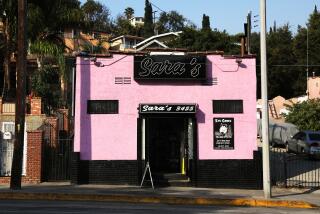Popping Up All Over New York City
No matter your age or proclivities, perhaps the best companion for a trip to Manhattan is a pocket-size pop-up map and guide called “New York City Unfolds.”
I know that sounds silly, but so do a lot of other things that work well. Like Velcro and yo-yos.
The map’s inventors have drawn fingerprints to show you where to put your thumbs to make it work. But soon you’ll be snapping it open with one hand--in search of a cross street or bistro.
Printed on the back of each map is a vivid, one-line review of restaurants, hotels, galleries and theaters. Essential data is included, from museum hours to cafe and theater phone numbers.
Fun to Use
It is a smart thing to carry in a city of newly arrived cab drivers. It is fun to have along to guide spur-of-the-moment decisions, and to inspire easy combinations of sights and tastes.
Examples: You’re walking along E. 20th Street, enjoying the quiet of Gramercy Park, and you realize it has been a long time since breakfast.
Flip open the map. Hmm. Union Square Cafe is only about five blocks away. Hubert’s is closer--and pricier--but the menu is nouvelle a nd that’s not your mood. So you opt for Union Square, a friendly hangout of the downtown publishing crowd.
Maybe you’ll find a tempting Italian deli along the way. It’s a pretty day. You can’t lose.
Similar pop-up maps are available in bookstores for cities such as Amsterdam and Zurich. The gnomes who make them have a toll-free number: (800) 321-MAPS.
Other discoveries, small and large, that I recently made in New York City:
The only flavor of ice cream sold at the cafeteria in the Metropolitan Museum of Art is vanilla-chocolate. They are not mixed; the cup is half-white and half-brown.
An 18th-Century oaken shop front that warms a corridor at the Metropolitan Museum originally stood at 3 Quai Bourbon on the north bank of Paris’ Ile St. Louis. Removed just before World War I, it was a gift of financier J. Pierpont Morgan Jr. (no relation).
The splendid mansion that is now the Cooper-Hewitt Museum (the Smithsonian’s National Museum of Design) was the family home of philanthropist Andrew Carnegie. In 1898 Carnegie announced his intention to build “the most modest, plainest and roomiest house in New York.”
A 64-Room House
The house had 64 rooms on six levels. It was home and office for the Scottish-born inventor and steel magnate, who moved in with his wife, their daughter and 19 servants. The adjacent garden, filled with wisteria, azaleas and chestnut trees, brightens the corner of Fifth Avenue and 90th Street.
A museum docent told me that the mansion was indeed “modest and comfy,” compared to the exquisite residence of Carnegie’s business associate, Henry C. Frick, whose Fifth Avenue mansion now houses the master paintings of the Frick Collection.
The Cooper-Hewitt Museum does not have a coffee shop, but a guard suggested that I could find a decent cup at Jackson Hole at Madison and 91st. The walls of Jackson Hole were hung with Western art. A sign in the window said: “Home of the Seven-Ounce Burger.”
I ordered a grilled cheese on rye, splurging 20 cents extra for Swiss cheese instead of American. It came with a big bowl of chilled cucumbers. Most of the patrons were from the neighborhood, or families on a museum spree. The coffee was not bad.
If you want a great cup of coffee in New York City between late June and the end of August, try the Colombian Coffee Summer Terrace on East 57th, between 3rd and Lexington avenues. Free Colombian coffee--hot or iced--is served at a sidewalk cafe near an exhibit on the culture and coffee production of Colombia.
And, according to my pop-up map, the shopping maze of Bloomingdale’s is just two blocks away.
More to Read
Sign up for The Wild
We’ll help you find the best places to hike, bike and run, as well as the perfect silent spots for meditation and yoga.
You may occasionally receive promotional content from the Los Angeles Times.






